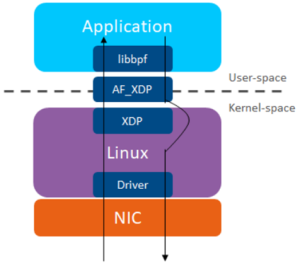To clarify:
- Impact on application adopting AF_XDP?
- How does it impact another app using DPDK/SR-IOV - on same node?
- How it works in virtualized environments?
Text WIP before creating PR:
Chapter 3 (before Energy Efficiency)
AF_XDP
Address Family For XDP (AF_XDP) is optimized for high performance packet processing and introduced in Linux kernel v4.18. This new socket type leverages the eXpress Data Path (XDP) in-kernel fast-path to transfer traffic frames from the NIC driver directly to userspace without the need for full network stack. XDP is an Extended Berkley Packet Filter (eBPF) software program.
By using the XDP_REDIRECT action from that XDP program, ingress frames can be redirected to other XDP-enabled network devices. The fastest working mode of operation is Zero-Copy mode in enabled XDP drivers.
Figure X: AF_XDP architecture
Chapter 5
Exposed Performance Optimisation Capabilities
Ref | Cloud Infrastructure Capability | Unit | Definition/Notes |
e.cap.025 | AF_XDP | Yes/No | Indicates if Cloud Infrastructure supports AF_XDP |
Table 4-2: Exposed Performance Optimisation Capabilities of Cloud Infrastructure
Profiles Specifications & Capability Mapping
Ref | Capability | Basic | High Performance | Notes |
e.cap.025 | AF_XDP | No | Optional | These Capabilities require workload support for AF_XDP socket type. |
Chapter 10 (last)
AF_XDP
Linux-native AF_XDP promises high enough packet processing performance and simplification compared to what SR-IOV and DPDK require for initial installation and later lifecycle management. Still, it will take time till AF_XDP-based solutions are financially invested and matured enough in both Virtualization Infrastructure and Network Functions.
